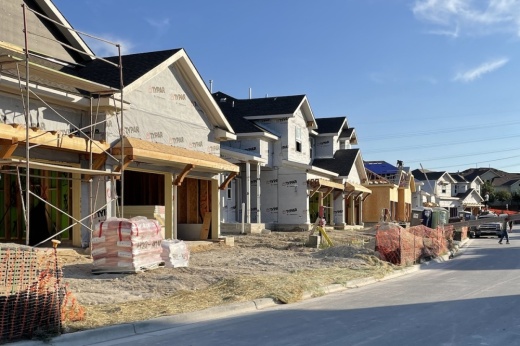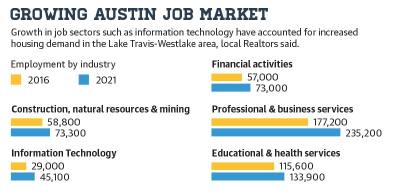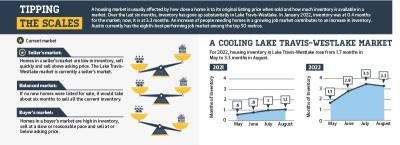Inventory alone, a key signal of market stability, has increased sharply in the last six months, and year-over-year data from the Austin Board of Realtors shows inventory in Lake Travis-Westlake has increased from 1.1 months in May to 3.3 months in August. For the Greater Austin and Round Rock metropolitan area, monthly inventory increased year-over-year from 2 months to 2.9 months.
“This is the most inventory we’ve had since 2018,” said Michelle Jones, an associate broker for Grossman & Jones Group. “Starting around June or July, things started to settle down. It’s a much better time for buyers to be in the market.”
A balanced market
Residential inventory for the Austin and Round Rock area, which began at 0.4 months in January, started to climb in the spring and peaked around July and August at 2.9 months, ABoR data showed.
Housing inventory, also called months of inventory, is used to determine whether a market is a buyer, seller or balanced market. A balanced market will have around six months of inventory, according to ABoR. Anything more typically indicates a buyer’s market and anything less is a seller’s market.
“These numbers are a breath of fresh air for a housing market that has been holding its breath,” ABoR President Cord Shiflet said in the June Central Texas Market Housing report. “The trajectory of our market over the last two years was unsustainable, and it was in no way going to last.”
While inventory may be increasing for the Greater Austin area, the number of sales continues to decline; this includes the Lake Travis-Westlake market.
In August of 2021, data shows home sales decreasing year-over-year by 3.7% to 1,935 sales in Travis County. In August of 2022, home sales dropped year-over-year by 28.9% to 1,361 sales in Travis County.
Sandy Cary, a global real estate adviser who handles properties principally in Lake Travis-Westlake, said the market is seeing more reluctance from buyers.
“We are not used to having homes just sit around,” she said. “We are not seeing people jump as quickly, and they are being cautious.”
Jones and Cary both put the number of days a home has been sitting on the Lake Travis-Westlake market around 30-45 days. According to data from ABoR, this is more than a 50% increase from 2020-21, when homes were getting taken off the market within days of listing.
“In some cases, homes were only on the market for a few hours [around the Lakeway and Bee Cave area],” Cary said. “I don’t remember having a day off during the pandemic.”
In an interview with Community Impact, Shiflet said it is important to put things in perspective.
“We saw numbers we’ve never seen before during the pandemic; it was a fluke,” he said. “In 2018-19, we would have killed to only have homes on the market for 30-45 days. Homes are selling close to listing price, and we are still in a seller’s market.”
However, more days on the market, homes being sold close to listing price and a steadily growing inventory means the housing market could finally be normalizing, Shiflet said.
“People are short-term in how they think about real estate,” Austin Real Estate agent Lisa Marie Contaldi said. “Soon, we are going to see less speculation and will be left with a needy market. More people will feel they need to sell than need to buy.”
If that happens, and more inventory is available, Austin and Lake Travis-Westlake could have a balanced market that mirrors pre-pandemic levels in the coming months.
While the Lake Travis-Westlake market sits at 3.3 months of inventory for August, a balanced market will have around six months of inventory.
The luxury component
While ever-increasing prices in Austin and Travis County continue to affect first-time homebuyers, the luxury market has remained strong over the last several years.
Ownership for luxury homes, houses generally priced close to $1 million and above, is less affected as there has been less of a shortage in higher-priced homes since 2021, Contaldi said. In Lake Travis-Westlake, homes priced over $1 million made up about 39% of the market listings in August 2021. That number jumped to approximately 63.1% when home prices $750,000 and above were added in. For August 2022, homes priced over $1 million now make up 40.5% of the Lake Travis-Westlake area; when homes priced $750,000 or above are added in, this amounts to nearly three quarters of the entire Lake Travis-Westlake market.
Staci Wimbush is the sales associate for Rough Hollow Realty and the director of marketing for Legend Communities. She said the 15 new homesites in Hacienda Heights, a new neighborhood in Rough Hollow in Spicewood with most homes priced over $3 million, received an “incredible amount of interest prior to building.”
“There are not many custom homesites around Austin like we have here in Rough Hollow,” she said. “The market for new, custom-built homes is very much in demand.”
Wimbush expects all 15 homesites, plus one 18-acre homesite with a private drive in Hacienda Heights, to sell within months of being put on the market.
Of all the homes sold in Austin between 2020-22, nearly 25% were considered luxury, according to data provided by Contaldi from Pacaso, a property broker that specializes in owning second homes.
Luxury second home ownership continues to be on the rise because those buyers are not tied to a specific location for work and are unaffected by rate increases, Contaldi said. As to why people were so interested in moving to the Lake Travis-Westlake area, and Austin in general, the main reason is jobs, Jones, Cary, Contaldi and Shiflet said.
“Before the pandemic, Austin was growing at a moderate pace,” Shiflet said. “The pandemic brought a housing boom we didn’t expect, and people are flooding into Austin. People realize they can work from home, and they want to be here.”
According to the Austin Chamber of Commerce, in the last 12 months, 10 of the 11 major private industry sectors added jobs to the Austin metro, including 16,700 to leisure and hospitality and 25,300 to professional and business services.
Looking to the future
Local experts said people should be prepared for the market to change over the next few months as Austin heads into its busy season.
Austin tends to run opposite from other markets, Shiflet said. Due to extreme heat temperatures in the summer, people usually start house shopping after Labor Day. As more buyers flood the market, housing prices also continue to go up.
In Lake Travis-Westlake, the median residential home price for August sat around $914,000—a 6.6% year-over-year increase, according to ABoR.
“Buyers should know that a recession doesn’t mean falling prices,” Contaldi said. “A recession usually just means falling mortgage rates.”
Mortgage interest rates, which have continued to decline during the last six recessions, are less than 7% for 30-year and 15-year fixed plans.
Anything under 7% is historically low, Jones said. In addition to rising prices and falling interest rates, the ability to develop housing quickly will also impact buyers and sellers.
As of July, the average total housing development fees charged per unit for a suburban-style development in Austin are 80.4% higher, or more than $8,000 higher, than the average fees for a suburban-style development in the larger Texas metro areas, according to ABoR. Inflation, supply chain issues and government regulation also continue to be setbacks for the housing market, Shiflet said.
While housing prices, inflation, inventory and development issues will all change the market significantly in the coming year, Contaldi said people do not need to fear the uncertainty of the housing market.
“It’s really the sentiments of the consumer that drives the market,” she said. “The best advice I can give to anyone is to do the opposite of what everyone else is doing. When prices are high but interest rates are low, that is the time to buy.”








